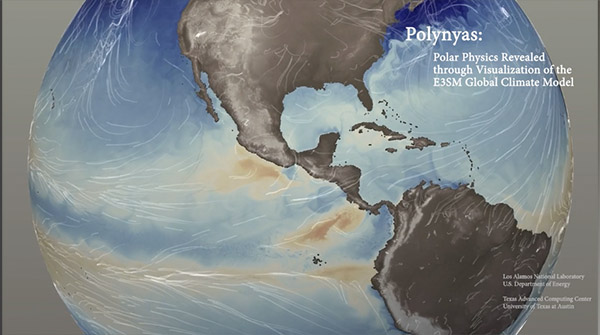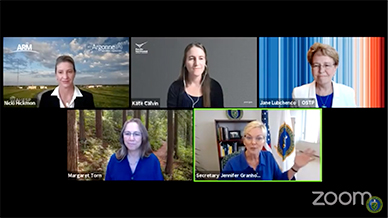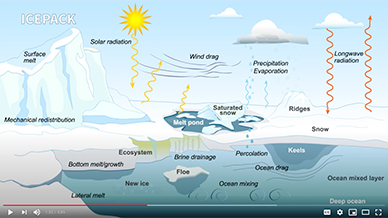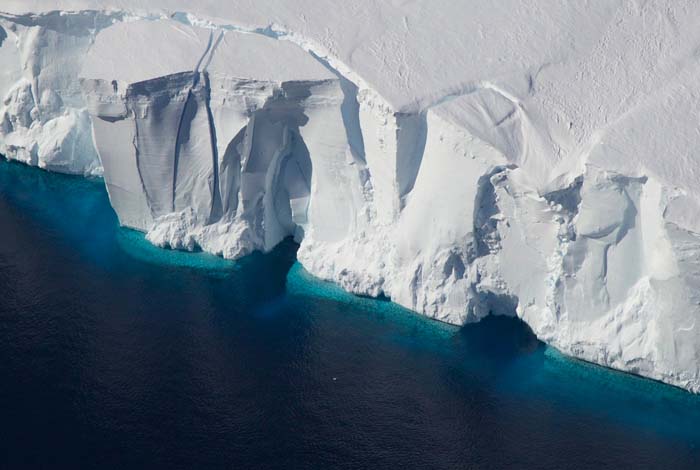Publicity: 2021
Collection of News Articles or Videos Relating to E3SM
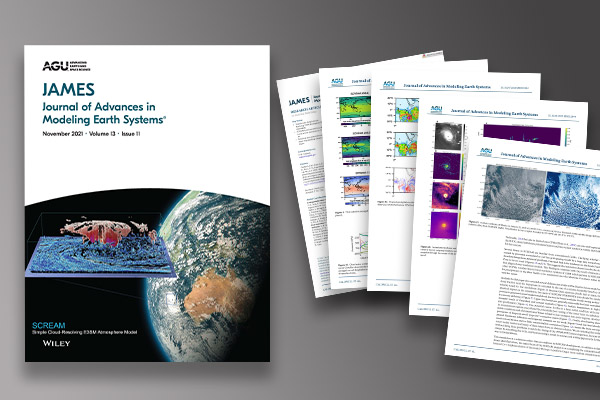
JAMES cover depicting a hurricane off the west coast of Australia on Feb 16th, 2020 at 0 UTC as simulated by SCREAM at 3.25 km resolution and the paper Caldwell et al, 2021.
November 21, 2021
SCREAM featured on the cover of JAMES
First results from simulations performed with the Simple Cloud-Resolving E3SM Atmosphere Model (SCREAM) were recently published in JAMES (Caldwell et al, 2021) and an image from SCREAM was chosen for the journal’s November 21, 2020 issue cover. SCREAM is a new E3SM Atmosphere Model being developed from the ground up in order to support Graphics Processing Unit (GPU) architectures and to run efficiently at a global resolution of 3 km cell length.
November 14, 2021
Entry video for Supercomputing 2021:
Polynyas: Polar Physics Revealed through Visualization of the E3SM Global Climate Model
Abstract, Video Summary: pdf, Video: mp4
The video highlights the role of polynyas in modulating earth’s mesoscale processes using high-resolution simulations from the Energy Exascale EarthSystem Model (E3SM).
Polynyas are openings within polar sea ice pack formed and sustained by atmospheric and oceanic processes. They occur in the Arctic ocean and the Southern ocean, lasting for many months, and act as a conduit for heat and water between the oceanic and atmospheric systems.
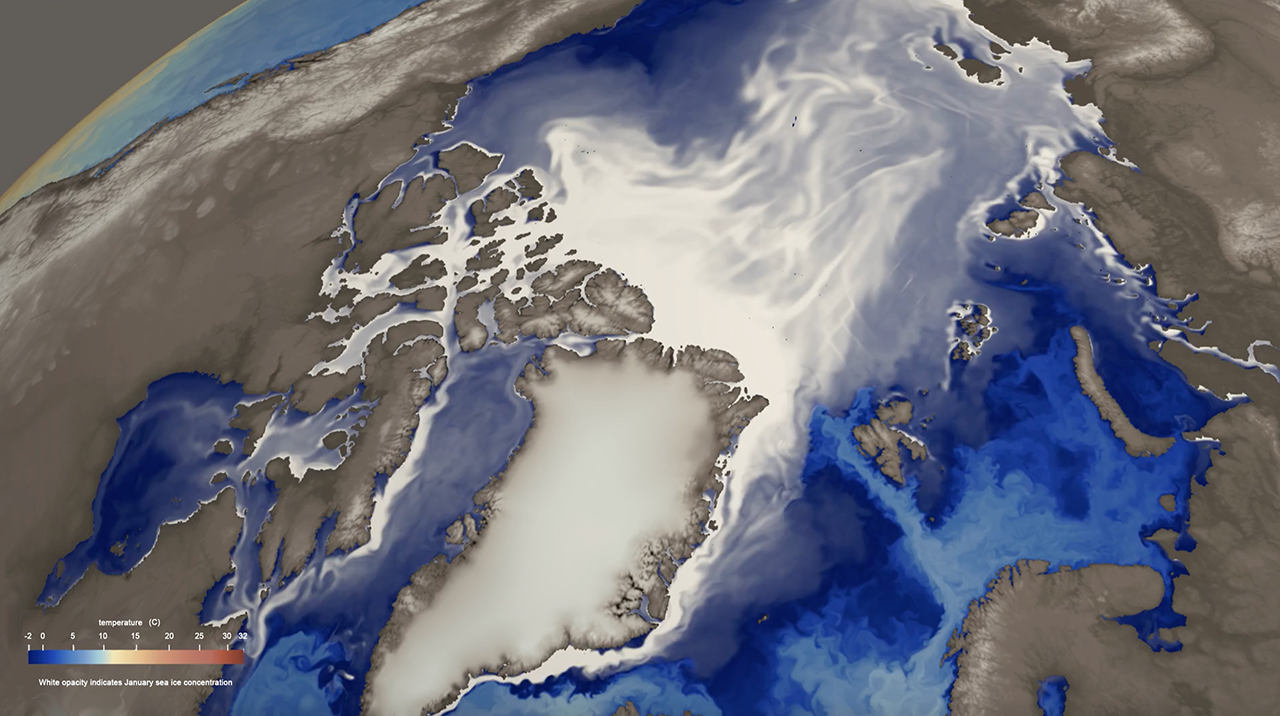
High-resolution E3SM simulation over the Arctic showing surface ocean currents and temperatures (blue) and January sea-ice concentration (gray/white).
October 25, 2021
LANL: Improved DOE exascale Earth system model two times faster than previous version
Los Alamos National Laboratory’s press release story on the E3SM version 2 model release.
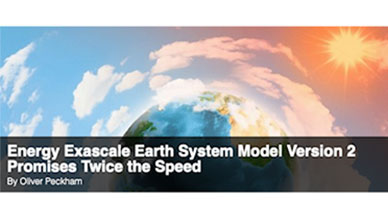
HPCwire features E3SM’s v2 release.
October 18, 2021
HPCwire: Energy Exascale Earth System Model Version 2 Promises Twice the Speed
The high performance computing magazine, HPCwire, featured a story on E3SM’s version 2 release, which included a key quote by scientist Chris Golaz from the LLNL and LANL press releases: “From one version to another, Earth system models typically become better but also quite a bit slower, so both faster and better is significant.”
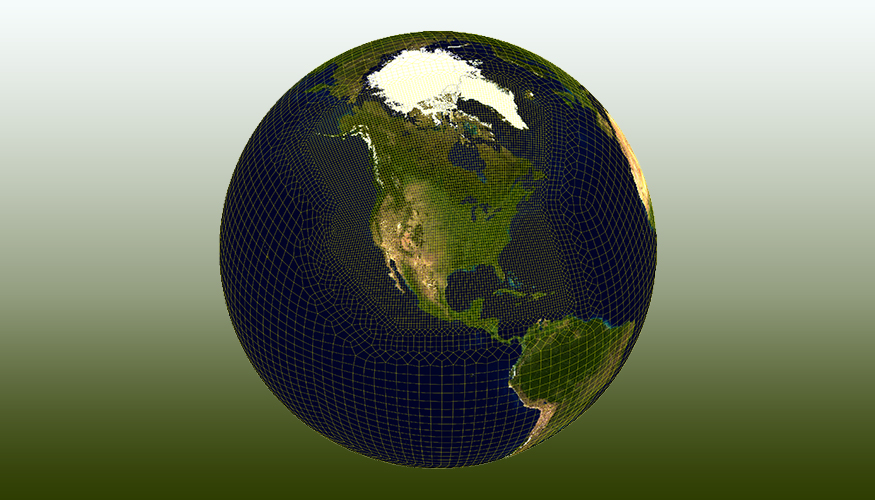
A model of the North American Regionally Refined Model grid showing the grid refinement that includes a 100-kilometer grid globally and 25 kilometers over North America.
October 14, 2021
LLNL’s press release: Updated exascale system for earth simulations
and
November 8, 2021
LBNL’s press release: Improved Earth System Model Could Help Better Predict Impact of Extreme Events
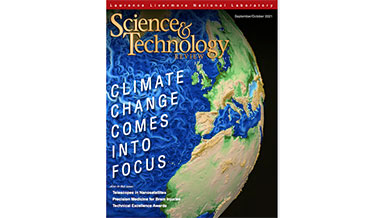
The cover image shows a simulation run on the Department of Energy’s (DOE’s) state-of-the-science Energy Exascale Earth Systems Model (E3SM), which leverages DOE’s advanced supercomputers for climate and earth science research.
September/October 2021
LLNL’s Science & Technology Review: Climate Change Comes Into Focus
Commentary by Dave Bader
The article describes, the newly released version 2 will be used to simulate aspects of Earth’s variability at weather-scale resolution and investigate decadal changes in climate that will critically impact the United States in coming years.
July 22, 2021
DOE Office of Science: Climate Research at the Office of Science Roundtable Discussion
E3SM’s BGC Lead Scientist Kate Calvin, participated in a livestream roundtable discussion with Energy Secretary Jennifer Granholm, Deputy Director for Climate and Environment at the White House Office of Science and Technology Policy Jane Lubchenco, Associate Director for Operations for DOE’s Atmospheric Radiation Measurement (ARM) user facility Nicki Hickmon, and Senior Advisor in the Climate and Ecosystem Sciences Division (CESD) of Lawrence Berkeley National Laboratory’s Earth & Environmental Sciences Area Margaret Torn.
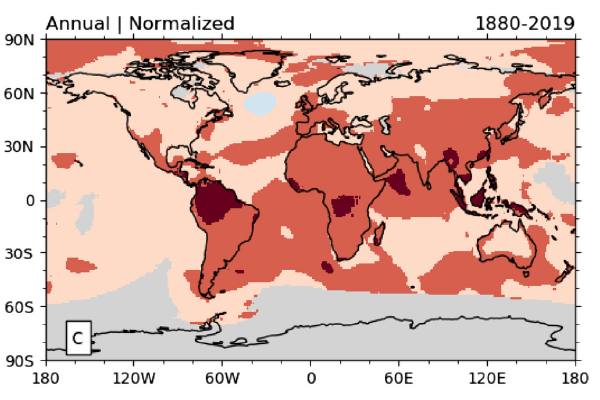
Polar warming is much faster than the mid-latitudes and tropics, and the warming over land is greater than over ocean, however it is unknown where more extreme heat events occur. New research shows more record-breaking temperatures and heat events will occur in the tropics rather than the poles.
June 10, 2021
World Economic Forum article: What climate change will mean for the tropics
E3SM and University of Arizona researcher, Xubin Zeng’s recent paper on “Quantifying the Occurrence of Record Hot Years Through Normalized Warming Trends” was highlighted in a World Economic Forum article based on a University of Arizona press release titled “Record-Breaking Temperatures More Likely in Populated Tropics.” The paper was also included in “AMS News You Can Use” and “AGU in the News.”
May 18, 2021
Los Alamos National Laboratory’s (LANL’s) YouTube Channel: R & D 100: CICE Video
LANL’s Elizabeth Hunke narrated a video about the sea ice model, CICE, and Icepack its column physics code. The video has been submitted to the 2021 R&D 100 Awards competition.
May 11, 2021
DOE Office of Science:
Tweet and Women @ Energy: Dr. Ruby Leung Article
Ruby Leung was mentioned in a DOE Office of Science Twitter post for Asian American and Native Hawaiian/Pacific Islander Heritage Month. The tweet referred back to a feature story the Office published on September 11, 2019 about Women working at the Department of Energy.
May 5, 2021
New York Times: Emissions Cuts Could Drop the Impact of Melting Ice on Oceans by Half
Washington Post: ‘Uncertainty is not our friend’: Scientists are still struggling to understand the sea level risks posed by Antarctica
LANL’s Press Release: Antarctica remains the wild card for sea-level rise estimates through 2100
LBNL/NERSC Press Release: Limit global warming to 1.5°C and halve the land ice contribution to sea level this century
All news articles and press releases include a discussion of the Nature paper titled “Projected land ice contributions to twenty-first-century sea level rise” which was published May 5, 2021. Several E3SM and SciDAC ProSPect team members were co-authors on the Nature paper.
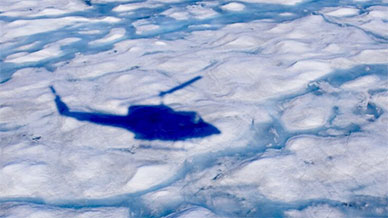
A helicopter flight over Greenland enabled UCI Earth system scientists to observe melt ponds. By gathering data from a network of weather instruments placed around the massive island, the researchers determined that surface melting of its ice sheet is coming mainly from the steady, day-to-day effect of wind- and solar-driven heat. Image courtesy of Wenshan Wang (UCI).
May 5, 2021
University of California, Irvine (UCI) News:
UCI researchers identify primary causes of Greenland’s rapid ice sheet surface melt
Understanding the relative importance of the various surface melt processes is helping scientists evaluate and improve Greenland’s surface melt in E3SM.
Researchers: Wenshan Wang (UCI), Charlie Zender (UCI), Dirk van As and Robert Fausto (Geological Survey of Denmark and Greenland, GEUS), and Matthew Laffin (UCI).
April 18-24, 2021
DOE Office of Science Twitter Feed:
For Earth Week, the Office of Science highlighted E3SM’s Earth systems modeling work by creating animated GIFs which they posted on the Office of Science’s Twitter feed. Some of the posts included the following tweets.
April 24:
Earth systems simulations can help us understand how & why Antarctic ice sheets may retreat in response to climate change. Research @BrookhavenLab, @LosAlamosNatLab & @SandiaLabs are revealing how that retreat will affect sea level rise. #ICYMI #EarthDay https://t.co/5F2z8AMCW4 pic.twitter.com/frl0xMA1pC
— DOE Office of Science (@doescience) April 24, 2021
April 23:
Many interacting systems form our planet's ecology. @ENERGY Earth systems models explore the impact of different variables on ecological outputs, like gross primary productivity (the amount of solar energy organisms store as carbon over time). #EarthDay https://t.co/IHPx437pu0 pic.twitter.com/wZ6SklwH8v
— DOE Office of Science (@doescience) April 23, 2021
April 22:
Story about E3SM on the Office of Science website: For Earth Systems Scientists, Every Day is Earth Day
April 21:
Cloud spotting is watching water vapor move. Understanding how the concentration of water vapor changes throughout the atmosphere (as in this animation) is essential to developing climate models that help us understand Earth’s past and future. #EarthDay https://t.co/X0MkSp2kE0 pic.twitter.com/iXoxF9kTsy
— DOE Office of Science (@doescience) April 21, 2021
April 20:
How will climate change affect severe weather events like tropical cyclones and droughts? Earth systems models supported by @Energy are helping us simulate events like this supercell thunderstorm under a variety of conditions. #EarthDay https://t.co/sblK1dugWE pic.twitter.com/ngKfqH6vBG
— DOE Office of Science (@doescience) April 20, 2021
April 19:
Even little kids know the water cycle. But each step has a ton of variables. Our Earth systems models portray these complex steps in 3D over time, helping us understand how climate change will affect our communities in the future. #EarthDay https://t.co/trILdI67hq pic.twitter.com/xk1eKOgVsp
— DOE Office of Science (@doescience) April 19, 2021
April 18:
To make decisions around climate change, local communities need the right info. @Energy is refining our Energy Exascale Earth System Model (E3SM) so it can have the best resolution on the planet & inform at-risk cities and groups. #EarthDay https://t.co/94vRyE6D3t
— DOE Office of Science (@doescience) April 18, 2021

This view toward the South Pole is a snapshot of the Antarctic Ice Sheet. (Courtesy of the Sculpting Vis Collaborative, Daniel Keefe, and Francesca Samsel.)
April 1, 2021
Physics Today:
Mingling Art and Science Opens Minds
Mark Petersen and Francesca Samsel of Los Alamos National Laboratory were interviewed for this Physics Today story on collaborations between scientists and artists. The article included their work on visualizing E3SM Antarctic ice shelf melt and ocean circulation data.

Daymet climatologies allow easy comparison of metrics like these monthly averages of maximum temperature for April (left) and August (right) of 2019.
January 29, 2021
Oak Ridge National Laboratory:
Earth System Informatics and Data Discovery
New Daymet Data Facilitate Environmental Science, Earth System Modeling
Researchers: Michele Thornton, Peter Thornton, Rupesh Shrestha, Shih-Chieh Kao, Yaxing Wei and Bruce Wilson.
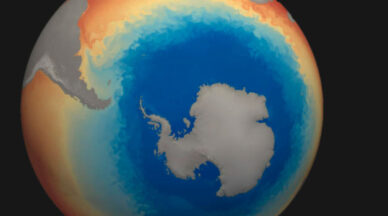
Los Alamos National Laboratory is studying the outcome of ice sheet melting in Antarctica and how it affects the environment around it.
January 24, 2021
Albuquerque Journal:
Are Visualizations the Future of Science?
by John Patchett, a Staff Scientist in the Information Sciences Group at Los Alamos National Laboratory.
Note: If you don’t have a subscription to the Albuquerque Journal, you’ll need to use Google Chrome and answer a few survey questions to read the article. (You do not need to buy a subscription.)


